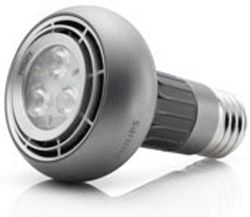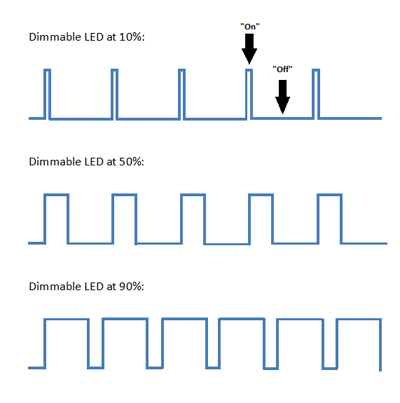Dimmable LEDs offer longevity PLUS superior energy efficiency — but how?
The benefits of dimmable incandescent and compact fluorescent light bulbs, that is, the ability to easily adjust the intensity of overhead lighting, improved energy efficiency, etc., are all greatly enhanced when dimmable LEDs are used instead.

Dimmable LED light bulb by Philips. (Credit: lightbulbmarket.blogspot.com)
But how, exactly, does this particular type of LED technology work? This has become a common question to ask as today’s consumer becomes more aware and thus more curious about the benefits of LED technology.
Background
First and foremost, LEDs are not dimmed based on an increase or decrease of voltage (as is the case with their incandescent counterparts.) Light gets emitted from a semiconductor chip, so it’s either on or off, and the LED will maintain its operation at the same voltage and current level as if it were operating at full light output.
Instead, what the LED does is it creates a “dimming effect.” There are two ways to do this: pulse-width-modulation (PWM LED) and analog dimming (sans cool-sounding acronym.)
Pulse-width-modulation LEDs
With pulse-width-modulation, the LED is wirelessly programmed to split its “on” time cycles, measured in milliseconds or thousands of a second, into intervals where the light is “on” and “off.” Take a look at the chart below.

Pulse-width-modulation is one way to dim LEDs.
For a low-lit light effect of just 10% brightness, the LED is “on” 10% of the cycle and “off” for the other 90%. For an LED light dimmed to 50% brightness, the light is turned “on” for half the cycle. Basically, the longer the “on” periods are relative to the “off” periods, the brighter the LED looks.
This, of course, begs the obvious question — why doesn’t it look like the light is blinking?
PWM LEDs rely upon the human eye’s ability to assimilate the average amount of light out of the pulses. As long as the rate is high enough, the eye won’t perceive any pulsing. Instead, it’ll recognize the overall average. To ensure the flickering is not noticed, the frequency of today’s PWM LEDs range from a few hundred to hundreds of thousands of pulses per second.
Analog dimming
Analog dimming is another way to dim an LED. In this scenario, the analog dimming supply controls the forward current being fed to the LEDs; its electronics linearly reduce the current so as to dim the LEDs.
While this technique is pretty simple to implement, and the efficiency of the LED is increased when run at a lower current (dimming reduces operating temperatures inside the light source), this particular type of LED doesn’t necessarily offer the best performance. That’s because it can turn out an inconsistent color as a result of the lower drive currents. This is particularly noticeable if different colored LEDs are used in a variety setting to produce white light. The amount of shift in current, particularly with red and yellow LEDs, can end up producing a low-quality white light.
Why’s it taking so long for dimmable LEDs to catch on?
The challenge for LED manufacturers is to design an affordable LED that can be retrofitted into existing installations, with the capability of being able to work with a variety of established dimming-control technologies as well as any emerging wireless-network-control scenarios. This is a tall order, to say the least. And while there are dimmable LEDS already available on the market, it still is a developing technology. As it continues to advance, prices will become more consumer-friendly, at which point we will likely begin to see a broader adoption of LED technology in more and more homes. ■
Related Products: LEDs and LED Lighting
Register for this free webinar on April 25, 2018 to learn how to maximize efficacy in your outdoor luminaire, sponsored by Lumileds and Arrow. Missed it? No problem, register to watch it on your own time.
Advertisement
Learn more about Electronic Products Magazine





